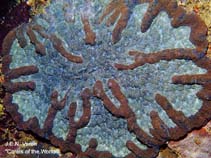Lobophyllia valenciennesii (Milne-Edwards & Haime, 1849)
Snake brain coral
Classification / Names Common names | Synonyms | CoL | ITIS | WoRMS
Anthozoa | Scleractinia | Lobophylliidae
Environment: milieu / climate zone / depth range / distribution range Ecology
Reef-associated; depth range 0 - 40 m (Ref. 848). Tropical; 36°N - 34°S, 26°E - 172°W (Ref. 848)
Distribution Countries | FAO areas | Ecosystems | Occurrences | Introductions
Indo-Pacific: East Africa including Red Sea to Melanesia, north to Japan and south to Australia.
Length at first maturity / Size / Weight / Age
Maturity: Lm ? range ? - ? cm
Short description Morphology
Formation: often flat. Valley: radiates from a flat central area; with steep sides and flat floors. Walls: moderately fleshy appearance, often with a groove along the top. Septa: thick, with large teeth. Polyps may be fleshy. Color: often gray, brown, or mottled; with contrasting valley floors and walls (Ref. 848).
Occurs in lower reef slopes away from wave action, and subtropical rocky foreshores (Ref. 848).
Life cycle and mating behavior Maturity | Reproduction | Spawning | Eggs | Fecundity | Larvae
Members of the class Anthozoa are either gonochoric or hermaphroditic. Mature gametes are shed into the coelenteron and spawned through the mouth. Life cycle: The zygote develops into a planktonic planula larva. Metamorphosis begins with early morphogenesis of tentacles, septa and pharynx before larval settlement on the aboral end.
Main reference
References | Coordinator | Collaborators
Veron, J.E.N. 2000. (Ref. 848)
IUCN Red List Status (Ref. 130435)
Least Concern (LC) ; Date assessed: 03 January 2008
CITES status (Ref. 108899)
Appendix II: International trade monitored
CMS (Ref. 116361)
Not Evaluated
Threat to humans
Human uses
| FishSource |
Tools
More information
Internet sources
BHL | BOLD Systems | CISTI | DiscoverLife | FAO(Publication : search) | Fishipedia | GenBank (genome, nucleotide) | GloBI | Gomexsi | Google Books | Google Scholar | Google | PubMed | Hexacorallians of the World | Tree of Life | Wikipedia (Go, Search) | Zoological Record
Estimates based on models
Preferred temperature
(Ref. 115969): 24.6 - 29.1, mean 28.1 (based on 1186 cells).
Price category
(Ref. 80766):
Unknown.



